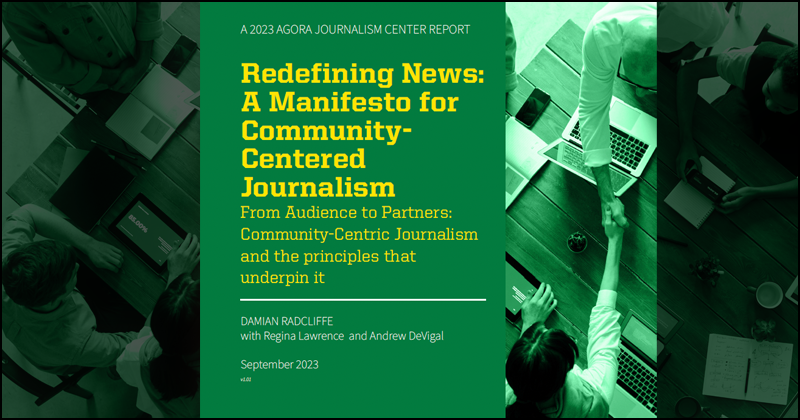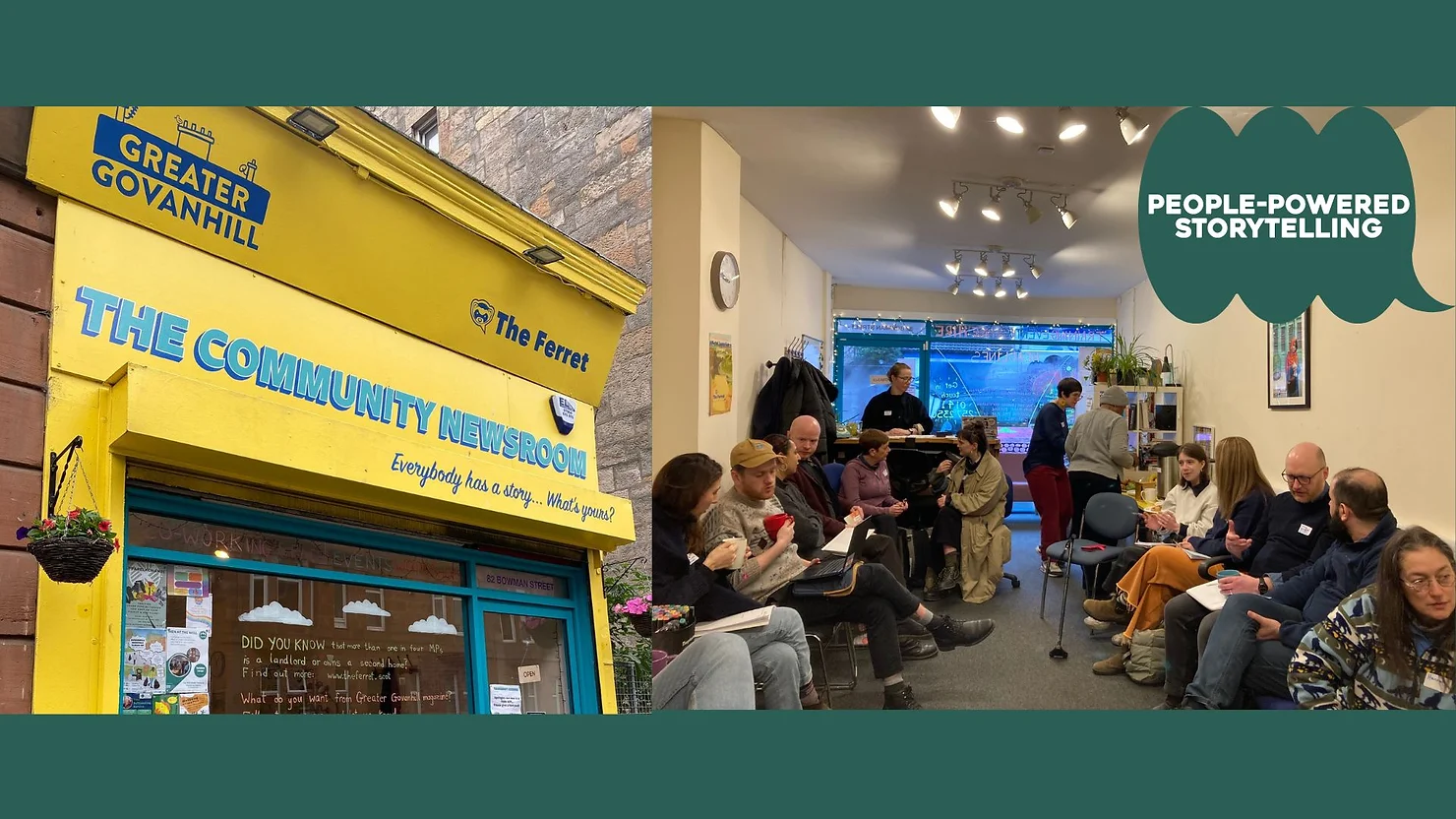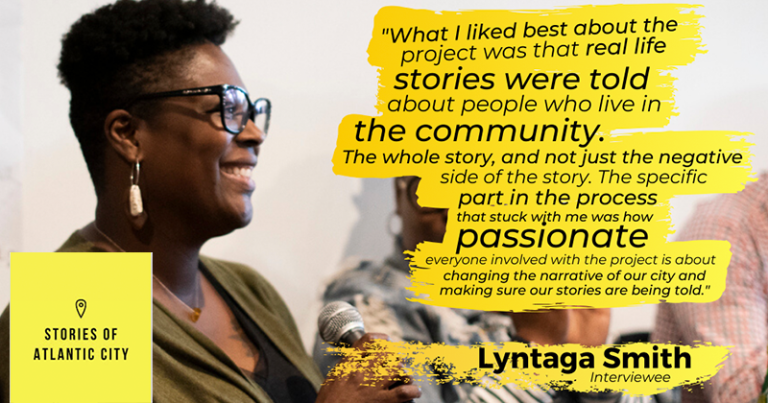In many parts of the world, journalism is in crisis. The industry faces challenges on multiple fronts, from an uncertain financial model, to declining levels of trust and growing news avoidance. The trajectory — unless we do things differently — is clear.
Amid this tumultuous backdrop, community-centered journalism (CCJ) offers one potential means to help address several of these existential challenges. This model, which I have explored over the past year in two separate reports for the Agora Journalism Center, emphasizes creating news for and with communities, rather than simply reporting on them.
To do this requires moving away from the traditional top-down model of newsgathering and distribution. In its place, it tasks journalists with building deep connections with communities, actively listening to them to understand their information needs, and involving them throughout the news-making process. In doing this, CCJ offers the potential to create journalism that is more inclusive, impactful, and service-oriented.
Here's what you need to know about community-centered journalism, and how newsrooms can adopt this transformative approach.
What is community-centered journalism?
At its core, community-centered journalism emphasizes creating news for and with communities rather than about them. It seeks to address long-standing inequities in journalism by amplifying underrepresented voices and focusing on the real information needs of diverse audiences. This approach involves deep listening, active collaboration, and a commitment to reshaping traditional reporting practices.
Unlike conventional journalism, which often assumes a top-down, gatekeeping role, CCJ shifts power dynamics. It values community input at every stage of the journalistic process — from identifying story ideas to determining how stories are told and distributed.
This collaborative approach redefines the relationship between journalists and the communities they serve. It does so through deep listening, relationship-building, and active community involvement. By fostering trust and transparency, CCJ can help to rebuild connections with audiences who may feel alienated by mainstream media.
Key principles of CCJ include:
- Centering community information needs
- Facilitating dialogue and understanding
- Building trust and promoting equity
- Adopting a "belonging and service" mindset
- Creating reciprocal rather than extractive journalism practices
In focusing on these principles, CCJ aims to produce more relevant, trusted, and impactful journalism, truly serving community needs in the process.
Why is community-centered journalism needed?
Community-centered journalism doesn’t hold all the solutions to the problems that journalism faces today, but it can play a role in helping to tackle some of its biggest challenges, namely:
(1) Rebuilding trust
Trust in journalism in multiple countries is at, or near, historic lows. According to the 2024 Digital News Report, only 40% of respondents globally said they trust most news. CCJ offers a potential remedy to this problem by prioritizing transparency, representation and relevance, making communities feel seen, heard and valued.
(2) Addressing news avoidance
Many audiences deliberately avoid the news, often because it feels irrelevant or overly negative. CCJ counters this by focusing on reporting that addresses real community concerns and identified information needs.
(3) Enhancing sustainability
By aligning journalism with community needs, CCJ can help newsrooms identify untapped audiences and revenue streams. Partnerships, grants and membership models may be easier to secure when a newsroom demonstrates tangible community impact. Furthermore, CCJ can also help to engender more civic engagement by providing communities with relevant, actionable information.
(4) Fostering innovation
CCJ encourages experimentation with new formats, platforms and storytelling techniques, enabling newsrooms to better serve audiences where they are. It also encourages greater diversity and inclusion in news coverage, which is much needed.

Cover image for Redefining News: A Manifesto for Community-Centered Journalism.
How to practice community-centered journalism
Transitioning to a CCJ approach requires a shift in mindset, practices and priorities for many journalists and newsrooms. In particular, these five actionable steps need to be integrated into what you do and how you do it:
(1) Understand community needs
Fundamental to CCJ is knowing what your audience truly cares about. Tools like community surveys, listening sessions, and focus groups can help uncover these needs. For example, prior to launching, Oakland-based El Tímpano used a nine-month listening initiative to identify critical issues for Latino immigrants, leading to content that directly addressed their concerns. Other outlets have adopted a similar approach rooted in deep listening.
“Humility [and] awareness go a long way toward doing good work in community-centered journalism,” said Eve Pearlman, CEO and co-founder of Spaceship Media. “Bring genuine curiosity about what you don’t know, don’t see, etc. Your way of seeing / your values, [your] ideas are not the only way, the right way, etc.”
(2) Map information ecosystems
Understanding how information flows within a community is essential. News outlets are not the only source of information that communities tap into. Because of this, newsrooms should identify key influencers, physical spaces (like libraries or cafes), and digital platforms where people share and consume news. Asset mapping, a technique borrowed from community development, can help pinpoint these nodes.
Take inspiration from The Trace’s Up the Block project, which created a resource list — in English and Spanish — for Philadelphia residents based on feedback about their needs following gun violence incidents.
(3) Meet communities where they are
Effective journalism isn’t just about what you report — it’s about how and where you distribute it. Whether it’s WhatsApp groups, pop-up newsrooms in libraries, or SMS services, meeting audiences on their preferred platforms — and in their preferred physical and digital space — increases engagement and helps to build trust and transparency.
Outlier Media in Detroit exemplifies this by using text messages to deliver vital information to underserved communities. TXT OUTLIER is an SMS service that not only delivers critical information to Detroit residents, it also allows people to engage directly with their reporters.
Similarly, Greater Govanhill, a multilingual award-winning community magazine serving the Govanhill area of Glasgow, Scotland, opened a community newsroom to make its journalism more accessible and participatory.

Image via the Public Interest News Foundation.
(4) Commit to diverse storytelling
CCJ requires newsrooms to involve communities in storytelling, ensuring a diversity of perspectives and voices are amplified and at the heart of journalistic practices. To support this, outlets have explored mechanisms such as creating community advisory boards, or listening sessions like Tortoise Media’s “ThinkIns.”
As Candice Fortman, a JSK Fellow and former executive director of Outlier Media told me while being interviewed for this report series, journalism must move beyond chasing awards or clicks to being more community service-oriented. To ensure that all parts of your business are pulling in the same direction, that means aligning editorial goals with business strategies and community needs. This triangulation is critical for long-term success.
(5) Focus on solutions and positivity
While traditional journalism often highlights problems, CCJ may embrace a more solutions-oriented style of reporting. By showcasing community resilience and creativity, journalists can foster a sense of pride and hope.
The Stories of Atlantic City project, for instance, used a restorative narrative lens to celebrate the strength of local communities, challenging negative stereotypes and fostering meaningful dialogue.

Image via the Gather platform.
Implementing a community-centered approach
Community-centered journalism isn’t just a response to journalism’s challenges — it’s an opportunity to reimagine its future. By fostering trust, inclusivity and collaboration, CCJ has the potential to create changes that are long overdue, namely a more equitable and sustainable media landscape.
Adopting CCJ isn’t necessarily easy. Resistance to change, limited resources, measuring impact, and time constraints all pose significant challenges. However, if we want to create more relevant, impactful journalism that directly addresses information needs, we must invest in efforts that purposefully foster deeper connections between newsrooms and communities.
As Madeleine Bair, the founder of El Tímpano told me, “You can have all of the fact-checking that you want, [but] If community members don’t trust your organization, then [...] it doesn’t do any good.”
Because of this, she recommends behaviors inherent in the ideals of community-centered journalism. “Time spent in developing relationships and listening is time well spent,” she said. “Once you invest up front in building relationships of trust, and in listening to the audience that you’re seeking to serve, it pays back in dividends.”
For more on the ideas and case studies in this article, check out Damian’s two reports, Redefining News: A Manifesto for Community-Centered Journalism and Advancing Community-Centered Journalism. You can also read these reports on a chapter-by-chapter basis on his Medium page.
Photo by Mathew Schwartz on Unsplash.


